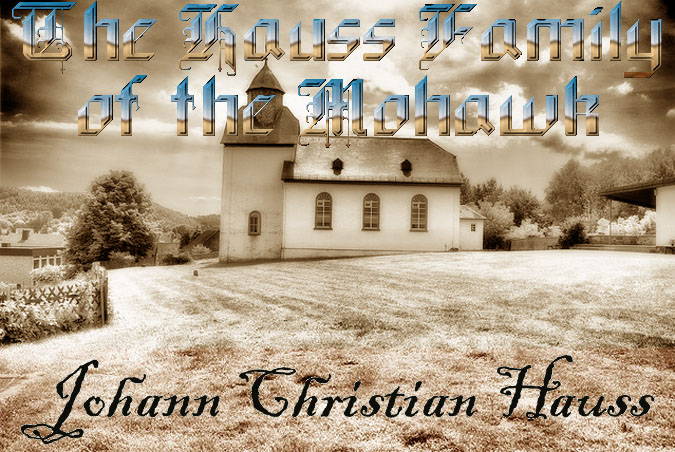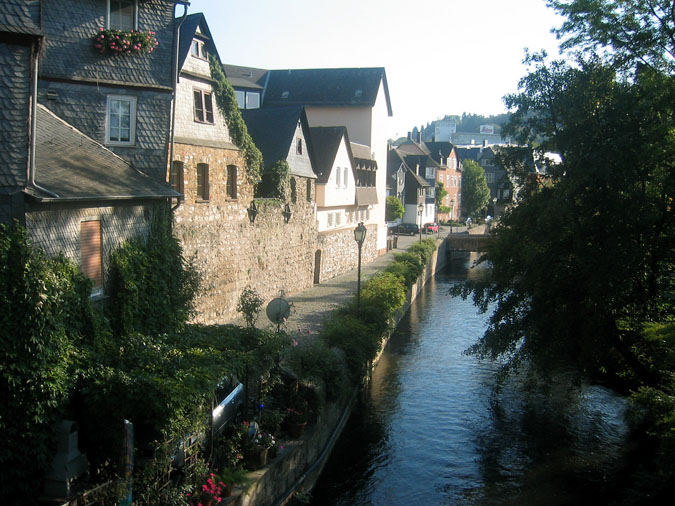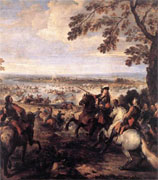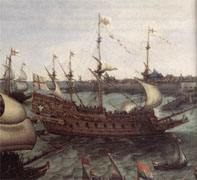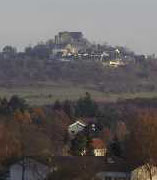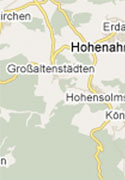|
|
"The German is like a willow. No matter which way you bend him, he will always take root again."
—Alexander Solzhenitsyn
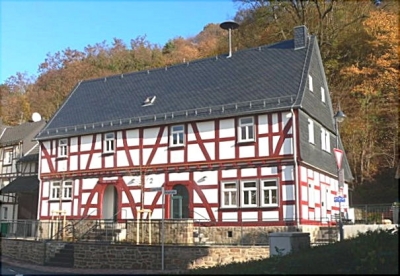 The "Old Backhouse" in Großaltenstädten, built in 1578, was once a school and town hall; now it's a village shop and cafe.
|
Sometime around 1666, JOHANN CHRISTIAN HAUß, our earliest known direct ancestor, was born. All we really know of his heritage is what he would tell the Reverend Joshua Kocherthal in 1710, recorded in the East Camp church book: He was "a carpenter, of Alten-Staeden, near Wetzler, duchy of Solm." The village of Großaltenstädten was known throughout Germany at that time for the quality of its half-timber houses—which would make it the logical hometown of a carpenter. He also could have lived a few miles away, in Kleinaltenstädten, or somewhere in between. Wherever he lived, we know that times were bad there.
When Johann Christian was born, the ruler of Solms-Hohensolms was probably Johann Heinrich Christian, who reigned as Graf (Duke) zu Solms-Hohensolms from 1644 to 1668. (It was customary at the time to name a child after the local ruler, which might be why our ancestor was named "Johann Christian.")
Information on the early life of Johann Christian Hauß is practically non-existent. Still, we can be sure it was a pretty rough childhood. The average number of children born to each marriage in this area was fairly large at the time—from 6 to 12, depending on the age at which the mother married—but the mortality rate was also very high. Childhood diseases and smallpox were rampant, a lack of basic sanitation control had created epidemics of cholera and typhus, and the spectre of the plague was always present. (During 1667 and 1678, the nearby town of Mannheim lost half its population to the disease.) As a result, a married couple would only raise three or four of those 12 children to any stage of healthy adulthood.
Therefore, we can assume that Johann Christian Hauß had plenty of siblings, although few would have survived. One may have been Daniel Hauß, who was registered at Königsberg in 1694.¹ We can also assume from all of this that Johann Christian Hauß was a tough, resilient young bauer (peasant) who could do whatever it took to survive.
|
|
"Justice is the insurance which we have on our lives and property. Obedience is the premium which we pay for it."
—William Penn
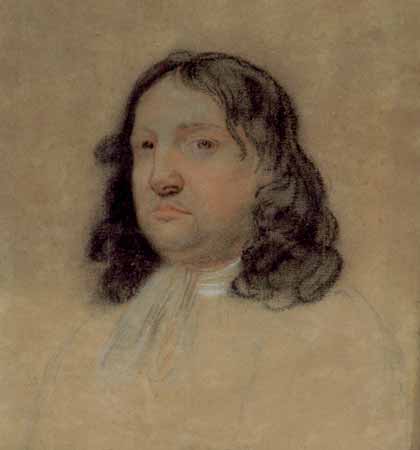
The only known life drawing of William Penn, circa 1695.
|
Graf Johann Heinrich Christian was Catholic in a very Protestant area, and was determined to cleanse the area of its "errors and heresies," which means our family was Catholic for at least a few years. But in 1668, Heinrich Christian was killed in a duel. He was succeeded by Johann Ludwig (1646 - 24 Aug 1707), who took power in 1668 as the sole Graf zu Solms-Hohensolms, and the Hauß family most likely became Protestantisch again.
Then around 1677, when Johann Christian Hauß was ten or eleven, he may have heard about William Penn, who was then touring the Rhine to promote a new land across the ocean, where you could decide for yourself what to believe and which religion to follow. Penn found a receptive audience in the area—and it's probably when Johann Christian Hauß first heard of America.
We know that the industrious Christian² became a carpenter, as mentioned earlier. It was a well-chosen career, because a carpenter could always find work in a town that was ransacked and destroyed on a continual basis. But living in that sort of squalor also meant there wasn't much chance for Bürgerrecht.
Still, Christian prospered enough to marry a local beauty, probably named MARIA CATHARINA. According to family lore, they had six sons... or the term a peasant carpenter calls his male children: "cheap labor," and a daughter.³ Those children were:
CHILDREN OF JOHANN CHRISTIAN & MARIA CATHARINA HAUß |
|
|
|
|
|
|
|
|
|
|
|
|
|
|
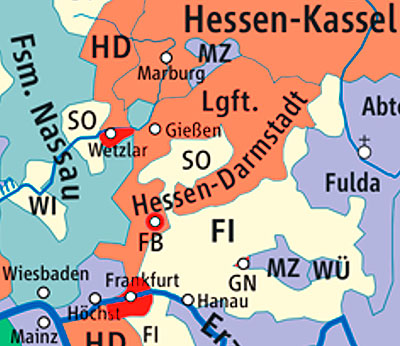 The dominion of the Solms noble family in 1648 (marked with 'SO').
|
In the latter 17th Century, the various Germanic states had struggled to recover from the Thirty Years' War. So local rulers eased immigration laws and offered religious tolerance, drawing new people from outside the Holy Roman Empire, including the Swiss, French, Dutch, and Scandinavians. Another cause of the growth was a high fertility rate which overcame the high level of infant mortality and epidemics. (Hey, when you're poor and unemployed, what else do you have to do?) By 1700, commerce had just about recovered and the population levels had returned to those of 1600. In a few areas, the growth had been so strong that the population had reached unsustainable levels.
One way for the various Kings, Margraves, Dukes and Noble Lords to get rid of the excess men was to sell them off as soldiers to other countries. For instance, in 1677-1678, Hessian troops fought for Denmark, against Sweden. In 1688, Hessian troops in fought for Venice, against the Ottoman Empire. In 1702, nine thousand Hessians served under the maritime powers. In 1706, eleven thousand, five hundred men were fighting in Italy. But England was the best customer: Through a large part of the eighteenth century there were Hessians in her army (in fact, our ancestors in the New World would end up fighting mercenaries from Solms, then part of Hessen, in the American Revolution—some of them even named Hauß).
|
|
There was fighting to do at home, too: In the 1670's, a French move to expand into the Empire started another war. Then came the 'War of the Grand Alliance' in which Louis XIV, who was claiming part of the Palatinate for France, fought the League of Augsburg—a coalition of European princes who refused to hand over their land. The conflict lasted eight years, from 1689-1687. What land that Louis didn't want, he destroyed. In fact, he even destroyed a lot of the land that he did want!
Finally, the Treaty of Ryswick restored the contested lands... But by that time the land had become so ravaged that many of the inhabitants fled the area entirely, some following William Penn and becoming the earliest German settlers of America—the Pennsylvania Dutch.
Those who stayed behind were then faced with the War of Spanish Succession, from 1702-1713, which completed the destruction of the area. The farmland became barren and charred, villages were destroyed, and the inhabitants were imprisoned, burned at the stake, broken on wheels or drowned.
|
|
|
|
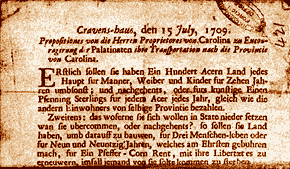 |
"They have endured one hundred years of war—King Gustavus Adolphus burned the city of Spiers in 1633. Invaded by Imperialists in 1644, by Germany in 1676 and by the Dauphin in 1688. Restored to the German Empire by the Treaty of Reswish, then destroyed by the French in 1693 who made a desert of 2,000 cities, towns and villages; destroying their vines with design to make so fatal a waste that the country might never be peopled or inhabited again. Vast numbers of Palatines perished in the woods and caves, among the wild beasts, through hunger, cold and nakedness."
—From a House of Commons investigation of the "Poor Palatines now living in London," as recorded in the "Ecclesiastical Records of the State of New York," Vol. 111
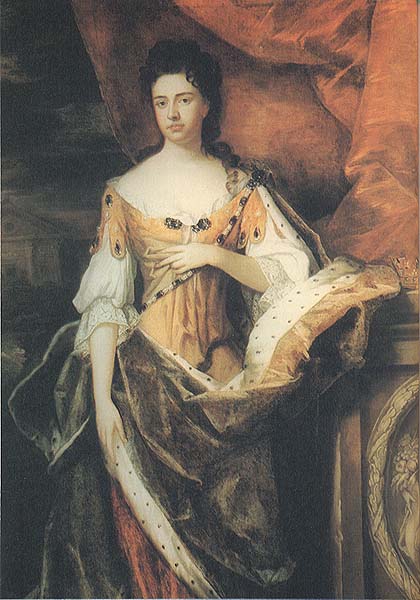 |
Queen Anne then agreed to send Kocherthal and a group of forty colonists to Carolina, not only funding their travels but also by supporting the colonists until they could get established. Kocherthal's report of this in an appendix to the third and fourth editions of his book caused a sensation in the region. The New World became more than an escape for these impoverished people—it became the Promised Land. Soon the rumor circulated that Queen Anne might be willing to support another group from along the Rhine. While Kocherthal had made no promises in his book, the possibility was there. And possibility was the best that someone living in poverty in Solms like Johann Christian Hauß could hope for.
During 1709, approximately 13,500 German and Swiss emigrants would apply for passage to the English colonies... and after seeing all of the death and destruction in his country, it sure must have sounded good to Johann Christian Hauß.⁴
|
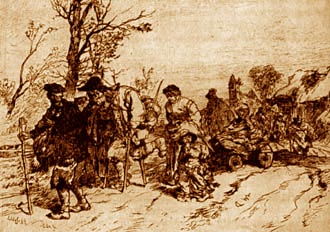 |
|
|
Kocherthal had persuaded Queen Anne that Palatine labor would be a valuable asset in establishing and fortifying her colonies, so the Board of Trade suggested that the new load of Poor Palatine refugees should be settled in Antigua. But upon the opinion that these cold weather Europeans would not be suited to working in the hot climate of the West Indies, it was then suggested that they be directed to the Hudson River Valley in the Province of New York, instead. (After all, Indian attacks and below-zero winter temperatures were much more enjoyable than drinking rum and coconut milk on a sunny beach, right?) The Germans would be used on the frontier, as a buffer against the French and the Indians. (In other words, the Palatines would be stationed on the land that would be attacked first, giving the British time to prepare. It was also hoped that through Palatine trade and intermarriage with the Native Americans that France would lose the support of the Indian Nations.)
The British decided to send some 3,000 refugees to America, from the Palatinate, Franconia, the Archbishoprics of Mayence and Trèves, and the districts of Hessen-Darmstädt, Hanau, Nassau, Alsace, Baden, Würtemberg and Zweibrücken. Although the name "Palatine" would be used indiscriminately by the British to describe all of the travelers collectively, they were actually from hundreds of different provinces in the region, with numerous local governments, religions, and the various nationalities (many were migrants who had relocated in these regions unsuccessfully). Collectively they were called Teutschen (the equivalent of "Germans" today), although If you asked Johann Christian Hauß what he was, he was more likely just to have answered tischler ("carpenter") than anything else.
Johann Christian Hauß made the cut to emigrate with the British, probably because carpenters were sorely needed to build new villages. So in the spring or early summer of 1709, his family was in a group that left for Rotterdam, the first stop on their journey. They traveled by riverboat on the Rhine River, and then made their way to Holland. The mood was hopeful, even jubilant, and they sang hymns all the way to Rotterdam, leaving their homelands behind. There would be new opportunities in the Colonies: towns to be built, houses to be razed—and carpenters would be needed... and most importantly, there would be land: Fresh, unspoiled land where Christian and his children—and their children—could finally prosper. He wanted that milk and honey. True Bürgerrecht.
Christian was in his forties, and several of his sons were already men, so some people may have wondered why he took such a risk so late in life (about a quarter of the emigrants were over 40, in fact). Most probably, he was thinking about the future of his family, and giving his descendants a chance to find and attain the happiness that had eluded him—with the hope that one day in the distant future, his great, great, great, great, great, great, great, great, great grandson would live in peace, and be free to write crappy movies and date bikini models. GOD BLESS AMERICA!!!
But it would be many months before the Hauß family would arrive at this land of opportunity with the "Wonder Fleet." Along the way he would face poverty, starvation, disease, and death—and would find that there wasn't any "milk and honey" waiting for him, either, in...
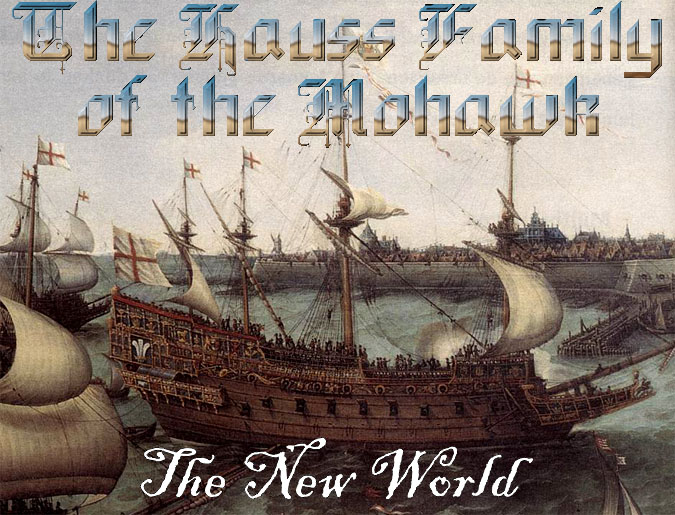 |
CHAPTER THREE: THE NEW WORLD,
1711 - 1725. Johann Christian Hauß arrives in the New World, with Johannes in tow—and that's when it really gets confusing.
TOP PHOTO: A small village chapel in Großaltenstädten, first mentioned in the year 1310. Its steeple is actually a fortified tower and its walls are thick, in order to protect the community in times of war. In 1797, the whole village, with its thatched wood houses, was destroyed by fire, with exception of this ancient fortified tower. The village was then rebuilt down near to the water, and the church, formerly in the middle of the village, now towers over it on the hill. In the German language, "Alten" means "old one," and a "städt" was a place that had a large number of inhabitants with a dense grouping of buildings, and a clear division of labor (town guilds).
NOTES
¹—Königsberg in Eastern Prussia was heavily damaged by Allied bombing in 1944 during World War II, and was subsequently conquered by the Red Army after the Battle of Königsberg in 1945. The city was annexed by the Soviet Union according to the Potsdam Agreement and largely repopulated with Russians. Briefly Russified as Kyonigsberg, it was renamed Kaliningrad in 1946 after Soviet leader Mikhail Kalinin. The city is now the capital of Russia's Kaliningrad Oblast.
²—According to the great genealogist Henry Z. Jones (this is a direct quote): "'Johann' was a prefix, sometimes used in old records, sometimes not—it's sort of like the 'Anna' in front of Palatine women's names. But 'Christian' was the name he was more likely known as. So, in a sense, your 'Sons of Johann' would more accurately probably be 'Sons of Christian.' But no big deal..."
³—Ken D. Johnson, Ft. Plank Historian and author of the book, The Bloodied Mohawk, says he has located a birth record for yet another son: Jost Haus, b. 1699 in Germany.
LITERARY SOURCES FOR THIS PAGE:
|
FOREWARDS: BY MELVIN RHODES SHAVER AND JEFF HAUSE CHAPTER 1: THE HAUß FAMILY IN THE DUCHY OF SOLMS CHAPTER 2: JOHANN CHRISTIAN HAUß CHAPTER 3: THE NEW WORLD CHAPTER 4: FROM HAUSS TO HOUSE CHAPTER 5: THE AMERICAN REVOLUTION
APPENDIX #1: JOHANN RHEINHARDT HAUSS GENEALOGY APPENDIX #2: JOHANN JURRIAN (GEORGE) HAUSS GENEALOGY APPENDIX #3: HOUSE LINES IN CANADA APPENDIX #4: HAUß HERALDRY |
